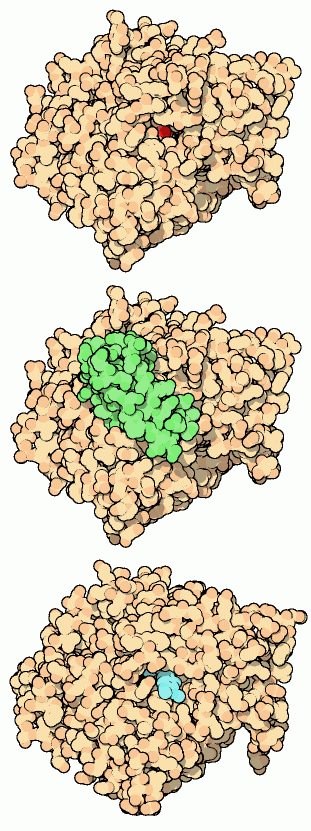|
Inhaltsübersicht | Nanomaschinen | Moleküle | Programme | Kurse | Fun | Links |
||
| > |
Acetylcholinesterase

Attacking Acetylcholinesterase
Since acetylcholinesterase has an essential function, it is a potential weak point in our nervous system. Poisons and toxins that attack the enzyme cause acetylcholine to accumulate in the nerve synapse, paralyzing the muscle. Over the years, acetylcholinesterase has been attacked in many ways by natural enemies. For instance, some snake toxins attack acetylcholinesterase. The picture at the top shows a view straight down the active site tunnel, from PDB entry 1b41, showing the active site serine in red. The middle picture shows how a lethal toxin from the eastern green mamba blocks the active site and poisons the action of the enzyme. For more information on snake toxins, take a look at the Protein of the Month at the European Bioinformatics Institute.
Doctors are now willfully poisoning acetylcholinesterase in an attempt to reverse the symptoms of Alzheimer's disease. People with Alzheimer's disease lose many nerve cells as the disease progresses. By taking a drug that partially blocks acetylcholinesterase, the levels of the neurotransmitter can be raised, strengthening the nerve signals that remain. One drug being used in the way is shown at the bottom, from PDB entry 1eve. It inserts into the active site pocket and temporarily blocks entry of acetylcholine. Other poisons, as shown on the next page, take a more permanent approach.
Doctors are now willfully poisoning acetylcholinesterase in an attempt to reverse the symptoms of Alzheimer's disease. People with Alzheimer's disease lose many nerve cells as the disease progresses. By taking a drug that partially blocks acetylcholinesterase, the levels of the neurotransmitter can be raised, strengthening the nerve signals that remain. One drug being used in the way is shown at the bottom, from PDB entry 1eve. It inserts into the active site pocket and temporarily blocks entry of acetylcholine. Other poisons, as shown on the next page, take a more permanent approach.
Next: Exploring the Structure
Previous: Acetylcholinesterase
Last changed by: A.Honegger,